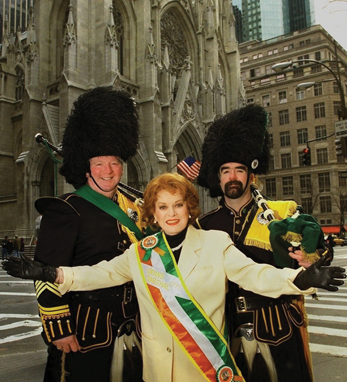84, still fiery and wearing red, Maureen O’Hara stood before 700 guests at the Irish Film and Television Awards in Dublin last September as she accepted the Lifetime Achievement Award. Coupled with the publication of her autobiography ‘Tis Herself, Ms. O’Hara has had a good year. These remarkable achievements only make up a handful of what the screen beauty has accomplished in her long life, and are only a partial justification for Irish America to choose her as Irish American of the Year.
O’Hara, born FitzSimons, started acting at the precocious age of 6. The Dublin of O’Hara’s youth didn’t typically encourage their own to pursue the arts, but the FitzSimonses were different in this respect. Maureen’s father was a football player and her mother was an operatic contralto. Maureen’s remaining five siblings also pursued theatrical careers. Her brother, Charles FitzSimons, for instance, became executive director of the Producers Guild, and was responsible for the original Batman television series. At 14, Maureen joined the Abbey Players, where she was discovered by actor Charles Laughton, who took her to London and changed her name to O’Hara. It was there that she made her first movie, Jamaica Inn, with director Alfred Hitchcock, whom she classifies as a “charming, kind, gracious, wonderful man.”
O’Hara was revered for brawn, brains, and beauty. She was dubbed the “Queen of Technicolor” due to her shimmering red hair and hazel-green eyes, but she wanted to be more than just another pretty face.
“Hollywood would never allow my talent to triumph over my face,” she complained. In what was then a male-dominated industry, O’Hara withstood the advances and abuse of some of the most powerful men in Hollywood, including director John Ford. “We were the property of the studio, and we had to do what they told us to do,” she confessed of what it meant to work in entertainment in the ’40s and ’50s.
Ultimately, she was able to prove herself as an actress of considerable talent. On-screen, she was the one actress who could stand up to the machismo of Hollywood’s leading cowboys, most notably John Wayne. Off-stage, she could match wits with the likes of Errol Flynn and Rex Harrison.
More amazing than O’Hara’s ability to stand tall in such a world is her nonchalance about what it involved.
When asked if it was difficult to exist in an industry she classified as “absurdly masculine,” she responded, “I was accepted as a guy.” O’Hara’s strength was constantly tested. During the making of The Quiet Man, she ruptured a disc and had to have surgery. Even so, she was not to be dissuaded from performing her own stunts. “The only stunt I never did was ride,” she confessed.
But the brassy broad, who John Wayne dubbed “the greatest guy I ever knew,” didn’t limit her feistiness to her studio roles. In 1957, she filed a defamation suit against the tabloid Confidential for its libelous claim that she was seen getting frisky in a back seat of a theater.
The event marked the first time an actor won a suit against the tabloids. She set another precedent when she took out American citizenship but refused to cite British as her former allegiance because she was a citizen of Ireland. Her stand changed the naturalization process, and other Irish natives were soon able to identify themselves as such.
O’Hara also survived an abusive marriage with her second husband, Will Price, whom she eventually divorced. After Price, Maureen met and married aviation pioneer Charlie Blair, who flew the first land plane with passengers and mail non-stop from the United States to Shannon. During their marriage, Blair died in a plane crash. Maureen took over his company, Antilles Airboats, after being elected CEO and president, making her the first woman president of a scheduled airline in the United States. Maureen later sold the airline with permission of the shareholders. ♦


Leave a Reply